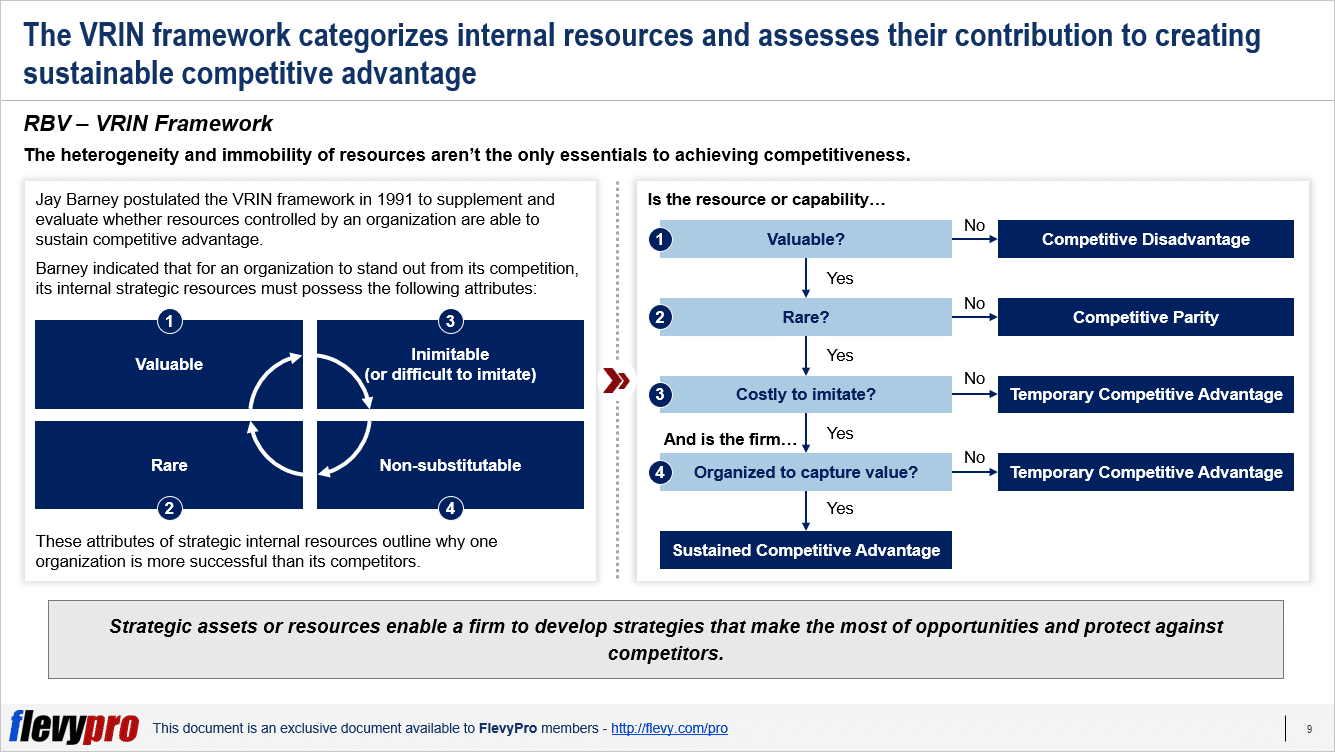Editor's Note: Take a look at our featured best practice, Core Competencies Analysis (17-slide PowerPoint presentation). Core Competencies Analysis is a powerful 5-phase business framework used to determine company-specific skills that enable differentiated value delivery. In other words, using Core Competencies Analysis, we can determine true competitive advantages of our company. This offers invaluable [read more]
Resource-Based View (RBV) and VRIN Framework
Also, if you are interested in becoming an expert on Strategy Development, take a look at Flevy's Strategy Development Frameworks offering here. This is a curated collection of best practice frameworks based on the thought leadership of leading consulting firms, academics, and recognized subject matter experts. By learning and applying these concepts, you can you stay ahead of the curve. Full details here.
* * * *
Michael Porter in the 1980s was a key proponent of Market-based Positioning view of achieving Strategic Competitive Advantage. However, with the advancement of technology, competition is becoming intense, work cultures are improving, and the workforce is getting increasingly competent to create better value propositions.
Research by various academicians and researchers has suggested other models of gaining profitability and sustainable competitive advantage. Rumelt, in his research in 1991, identified that, contrary to Porter’s idea of industry solutions as the main source of profitability, the key source of superior performance and profitability in large US corporations was at the individual organizational level instead of corporate level resources.
As per Pralahad and Hamel, distinctive competencies or capabilities of the organization make the key difference in achieving superior performance and competitive advantage. To understand the difference in organizations’ performance, the Resource-Based View (RBV) and VRIN is one of the most assuring methodologies. RBV argues that an organization’s internal resources—e.g., workforce with niche skills, key competencies, processes, and knowledge—are what matter most to outdo rivals. These internal resources are created, inhibited, and evolved over time.
RBV warrants the deployment of the right resources to the right projects to ensure enhanced productivity and seamless project execution.
According to RBV, resources can be tangible or intangible.
- Tangible resources include land, buildings, equipment, machinery, and capital. These physical resources can be easily acquired by rivals.
- Intangible resources include brand reputation, trademarks, and intellectual property.
Key benefits of using the RBV include:
- A strong internal focus, which enables companies to develop strategies based on their internal strengths and resources. These strategies are more effective and sustainable compared to those solely based on external market conditions.
- Prioritized resource allocation by focusing on internal assets, capabilities, and competencies.
- Informed Decision making by identifying unique resources and capabilities.
- A holistic understanding of how internal resources and capabilities interact and contribute to the overall enterprise strategic goals.
- Better navigation through uncertainties, risks, and vulnerabilities by focusing on internal strengths.
Jay Barney in 1991 postulated that for an organization to stand out from its competition and develop sustainable competitive advantage, its strategic internal resources must possess the following attributes:
- Valuable
- Rare
- Inimitable (or difficult to imitate)
- Non-substitutable
The VRIN attributes of strategic internal resources outline why one organization is more successful than its competitors.
Let’s now discuss the first two of the VRIN attributes.
Valuable
According to the VRIN model under the RBV, an organization’s resources are deemed valuable only if they aid in the achievement of its objectives, create demand for offerings, improve quality, increase revenue, reduce costs, differentiate the offerings in the market, or neutralize threats in the environment.
Valuable resources help the company operate more efficiently and effectively, making better use of its assets and opportunities in the market. Resources that add to the value offered to customers, such as brand reputation or unique technology, can enhance customer loyalty and willingness to pay a premium. For instance, the secret formula of Coca-Cola syrup is a valuable resource because its unique taste is highly appreciated worldwide and contributes to strong brand loyalty. This valuable resource allows the company to charge a premium price and maintain its market leader position. The syrup formula is carefully guarded, so no other competitor has been able to replicate the exact taste, providing Coca-Cola with a sustained competitive advantage.
Rare
A resource is considered rare if it is not widely possessed or easily accessible by competitors. This rarity of resources or capabilities make them hard to replicate.
Every organization has something that is exclusive to itself. Rarity makes a resource more valuable because its limited availability means that not every firm can use it to implement competitive strategies. Even if a resource is valuable, it will not be a source of competitive advantage if it is widely available to all competitors.
For instance, a prime location for a retail store can be a rare resource.
Interested in learning more about the other attributes of RBV and VRIN framework? You can download an editable PowerPoint presentation on Resource-Based View (RBV) and VRIN Framework here on the Flevy documents marketplace.
Do You Find Value in This Framework?
You can download in-depth presentations on this and hundreds of similar business frameworks from the FlevyPro Library. FlevyPro is trusted and utilized by 1000s of management consultants and corporate executives.
For even more best practices available on Flevy, have a look at our top 100 lists:

Want to Achieve Excellence in Strategy Development?
Gain the knowledge and develop the expertise to become an expert in Strategy Development. Our frameworks are based on the thought leadership of leading consulting firms, academics, and recognized subject matter experts. Click here for full details.
"Strategy without Tactics is the slowest route to victory. Tactics without Strategy is the noise before defeat." - Sun Tzu
For effective Strategy Development and Strategic Planning, we must master both Strategy and Tactics. Our frameworks cover all phases of Strategy, from Strategy Design and Formulation to Strategy Deployment and Execution; as well as all levels of Strategy, from Corporate Strategy to Business Strategy to "Tactical" Strategy. Many of these methodologies are authored by global strategy consulting firms and have been successfully implemented at their Fortune 100 client organizations.
These frameworks include Porter's Five Forces, BCG Growth-Share Matrix, Greiner's Growth Model, Capabilities-driven Strategy (CDS), Business Model Innovation (BMI), Value Chain Analysis (VCA), Endgame Niche Strategies, Value Patterns, Integrated Strategy Model for Value Creation, Scenario Planning, to name a few.
Learn about our Strategy Development Best Practice Frameworks here.
Readers of This Article Are Interested in These Resources

|
|
25-slide PowerPoint presentation
|
|
33-slide PowerPoint presentation
| |||
About Mark Bridges
Mark Bridges is a Senior Director of Strategy at Flevy. Flevy is your go-to resource for best practices in business management, covering management topics from Strategic Planning to Operational Excellence to Digital Transformation (view full list here). Learn how the Fortune 100 and global consulting firms do it. Improve the growth and efficiency of your organization by leveraging Flevy's library of best practice methodologies and templates. Prior to Flevy, Mark worked as an Associate at McKinsey & Co. and holds an MBA from the Booth School of Business at the University of Chicago. You can connect with Mark on LinkedIn here.
Top 10 Recommended Documents on Competitive Advantage
» View more resources Competitive Advantage here.
» View the Top 100 Best Practices on Flevy.















